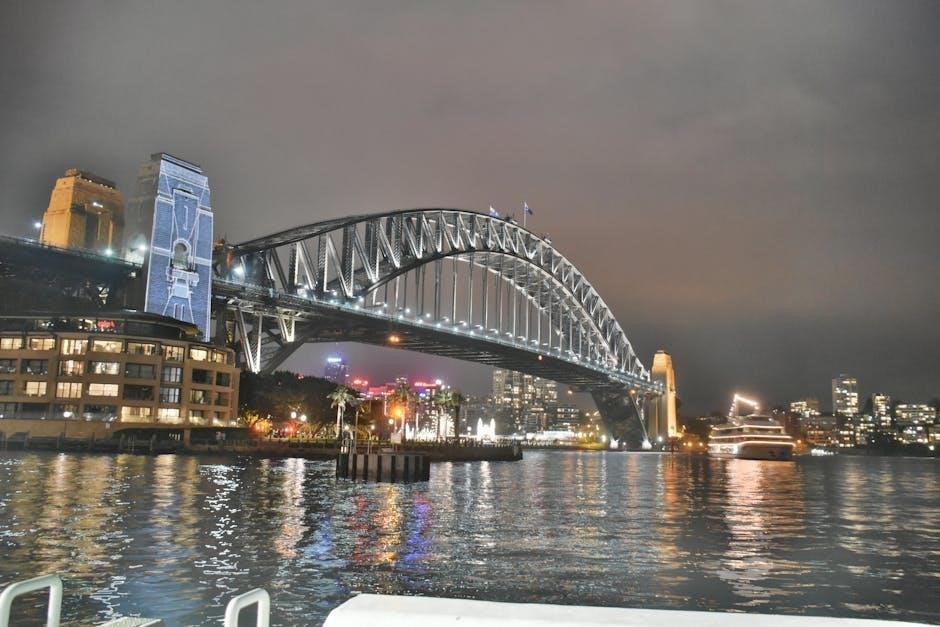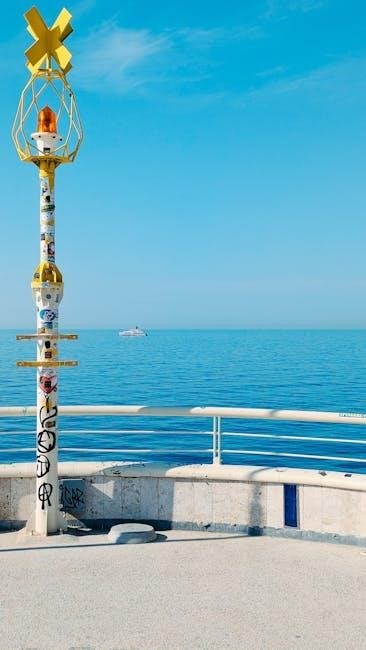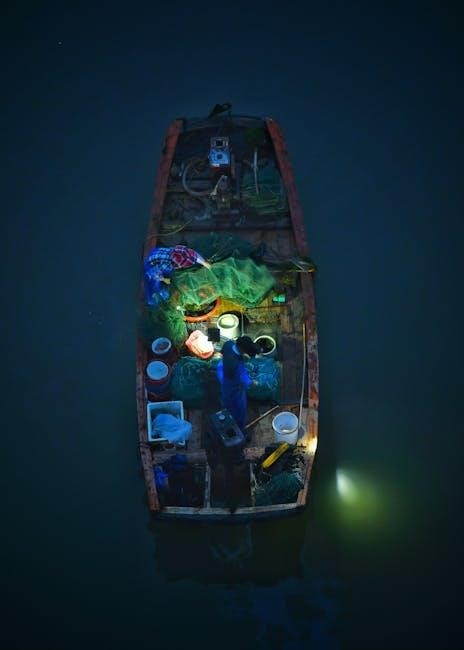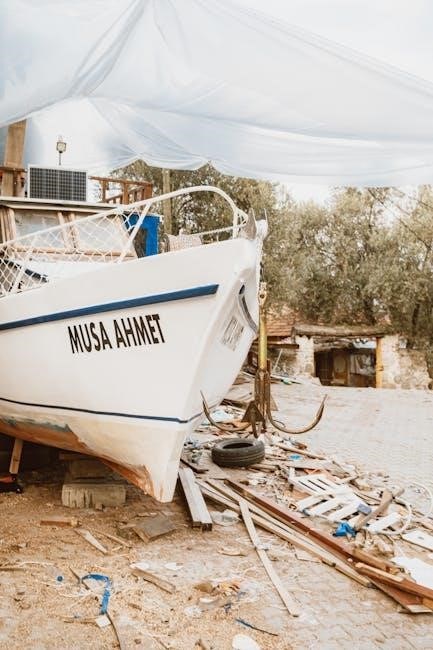Boat trailer guide post lights enhance visibility and safety while trailering․ They are easy to install, featuring bright LED technology for clear guidance and durability in marine environments․
What Are Boat Trailer Guide Post Lights?
Boat trailer guide post lights are LED or incandescent fixtures mounted on trailer posts to enhance visibility during towing․ They provide clear illumination for aligning the boat and trailer, especially in low-light conditions․ These lights are typically waterproof, durable, and designed to withstand marine environments․ They come in kits with wiring harnesses and installation hardware, offering a practical solution for improving safety and ease of use while trailering․ Their bright output ensures better visibility for drivers and bystanders, making them essential for secure boat transportation․
Importance of Guide Post Lights for Safe Trailering
Guide post lights are crucial for safe trailering, enhancing visibility and ensuring proper alignment of the boat on the trailer․ They illuminate the trailer’s position, making it easier to maneuver in low-light conditions․ These lights reduce the risk of accidents and damage by providing clear visual cues․ Their durability and water resistance make them reliable in harsh marine environments․ By improving visibility and ease of use, guide post lights are essential for secure and stress-free boat transportation, ensuring safety for both the driver and surrounding traffic․
Installation Guide for Boat Trailer Guide Post Lights
Align the lights on the trailer posts, drill mounting holes, and secure with hardware․ Connect wiring to the trailer’s electrical system and test functionality to ensure proper operation․
Tools and Materials Needed for Installation
For installing boat trailer guide post lights, gather essential tools and materials․ These include a Phillips screwdriver, pliers, a 1/8-inch drill bit, and a 9/16-inch deep socket․ Additionally, you’ll need a wiring harness, screws with eyelets for grounding, PVC post caps, and marine-grade adhesive for securing the light housings․ Ensure all components are compatible with your trailer and marine environment to guarantee durability and proper function․
Step-by-Step Installation Process
Begin by aligning the guide post lights with your trailer’s PVC posts, ensuring the lens faces rearward․ Secure the Pipe-Light housing using marine-grade adhesive and attach the top post cap․ Next, drill a 1/8-inch hole in the trailer frame for grounding, then use the provided screw and eyelet to connect each lamp․ Finally, hook up the trailer to your tow vehicle to test the lights, ensuring all functions work correctly before use․
Wiring and Electrical Connections
Connect the black wire from the guide post lights to the trailer’s white ground wire․ Attach the red wire to the brown marker/tail light circuit․ Ensure all connections are secure and protected from moisture․ Use a wiring harness to simplify the process, following the manufacturer’s diagram․ Test the lights by connecting the trailer to the tow vehicle to verify proper function․ Ground each lamp correctly to avoid electrical issues during use․

Choosing the Right Guide Post Lights
Select LED guide post lights for durability and brightness․ Ensure compatibility with your trailer’s wiring system and check local regulations for compliance with visibility standards․
Key Features to Look for in Guide Post Lights
Look for LED technology, water resistance, and durability․ Ensure lights are bright for visibility and include mounting hardware for easy installation․ Choose systems with wiring harnesses and ensure compliance with local regulations․ Adjustable brackets and high-visibility designs enhance functionality․ opt for lights with long-lasting performance and minimal maintenance․ Consider energy efficiency and compatibility with your trailer’s electrical setup․ These features ensure safety, reliability, and ease of use while trailering your boat․
LED vs․ Traditional Incandescent Lights
LED lights offer superior brightness, energy efficiency, and longevity compared to traditional incandescent lights․ They are more durable, resistant to vibration, and require less power, reducing battery drain․ LEDs are also water-resistant and provide instant illumination, making them ideal for marine environments․ While incandescent lights are cost-effective upfront, LEDs offer long-term savings and reliability․ For boat trailers, LEDs are the preferred choice due to their enhanced performance and lower maintenance needs, ensuring consistent visibility and safety during transport․

Maintenance and Troubleshooting
Regular inspections ensure guide post lights function properly․ Check connections, clean lenses, and inspect wires for damage․ Address issues promptly to maintain safety and visibility while trailering․
Common Issues and Solutions
Common issues with boat trailer guide post lights include intermittent lighting, wiring problems, and damage from marine environments․ For intermittent lights, check connections for corrosion or looseness and clean or replace them․ If lights dim or flicker, ensure proper grounding and inspect wiring for damage․ To prevent corrosion, apply a silicone-based protective spray․ For damaged lenses, replace them promptly to maintain visibility․ Regularly inspect and clean lights to avoid dirt buildup․ Addressing these issues ensures reliable performance and safety while trailering․
Regular Maintenance Tips
Regular maintenance ensures boat trailer guide post lights function optimally․ Clean lenses with a soft cloth and mild soap to remove dirt and salt residue․ Inspect wiring for signs of wear or corrosion and protect it with waterproof sealants․ Check connections regularly and tighten loose ones․ Replace any damaged or flickering LEDs promptly․ Apply a silicone-based protective spray to prevent rust and corrosion․ Store the trailer in a dry location during off-seasons to reduce moisture exposure․ Proper care extends the lifespan and reliability of your guide post lights․

Wiring Harness and Electrical Setup
A proper wiring harness ensures safe and efficient electrical connections for guide post lights․ Use a 4-pin or 7-pin connector, grounding each light to the trailer frame for reliability and safety․
Understanding Trailer Wiring Systems
Trailer wiring systems are designed to connect your vehicle’s electrical system to the trailer’s lights and accessories․ Most boat trailers use a 4-pin connector, which includes a ground wire, taillight/marker light circuit, turn signal circuit, and brake light circuit․ A 7-pin connector is used for heavier trailers and includes additional functions like reverse lights and auxiliary power․ Proper wiring ensures all lights function correctly, enhancing safety and visibility․ Always follow manufacturer guidelines and test connections before towing to avoid electrical issues․
Connecting Guide Post Lights to the Trailer Wiring
Connecting guide post lights involves linking them to your trailer’s wiring system․ Identify the correct wires in your trailer harness, typically marked for specific functions․ The ground wire (usually white) connects to the trailer frame, while the power wire (often brown) links to the marker or tail light circuit․ Ensure secure connections using solder or crimp connectors․ Test the lights by activating your vehicle’s signals to confirm proper function․ Always follow the manufacturer’s wiring diagram and safety guidelines to avoid electrical issues and ensure reliable operation while towing․

Customization and Upgrades
Customize your guide post lights with adjustable brightness, color options, or additional features like sensors for enhanced functionality, ensuring they meet your specific trailering needs and preferences․
Adding Extra Features to Your Guide Post Lights
Enhance your guide post lights with adjustable brightness, wireless control, or motion sensors for automatic activation․ Install LED strips for increased visibility or integrate cameras for real-time monitoring․ These upgrades improve functionality and safety, making trailering more efficient․ Ensure compatibility with your existing system and follow proper installation steps to maintain performance․ Such additions provide long-term benefits and adaptability for various trailering conditions, ensuring your setup remains modern and effective․
Advanced Setup for Enhanced Visibility
For enhanced visibility, consider advanced setups like dual LED configurations or integrating guide post lights with additional strips along the trailer frame․ Use high-intensity LED lights with adjustable brightness to customize illumination based on driving conditions․ Some systems allow synchronization with brake lights for improved communication to other drivers․ Advanced setups may also include camera integration for real-time monitoring or smart systems that automatically adjust light intensity․ These configurations ensure maximum visibility, reducing blind spots and enhancing overall trailering safety and maneuverability․

Safety and Legal Requirements
Guide post lights are essential for safe trailering and legal compliance․ They ensure visibility, preventing accidents and meeting state and federal lighting regulations for trailers․
Legal Requirements for Trailer Lighting
Trailer lighting must meet specific legal standards to ensure safety and visibility․ All trailers require brake lights, turn signals, tail lights, and side marker lights․ License plates must be illuminated․ Guide post lights enhance compliance by providing additional visibility, especially when backing or driving in low-light conditions․ LED lights are preferred for their brightness and durability, meeting federal and state regulations․ Always verify local laws to ensure your setup is compliant and safe for the road․
Ensuring Compliance with Local Regulations
Compliance with local regulations is crucial for safe and legal trailering․ Check state-specific requirements for trailer lighting, including the number and type of lights needed․ Ensure guide post lights meet visibility standards and are properly installed․ Regular inspections help maintain compliance and prevent legal issues․ Familiarize yourself with local laws to avoid fines and ensure your boat trailer setup is roadworthy․ Proper wiring and illumination of the license plate are also mandatory in most regions․

Customer Reviews and Experiences
Customers praise boat trailer guide post lights for their brightness and ease of installation, offering great value and enhancing visibility during nighttime trailering experiences․
Real-World Feedback and Recommendations
Many customers highlight the ease of installation and durability of boat trailer guide post lights․ They recommend opting for LED models for their brightness and longevity․ Users also suggest ensuring proper wiring connections to avoid electrical issues․ Additionally, aligning the lights correctly during installation is crucial for optimal visibility․ Overall, these lights are praised for enhancing safety and convenience during trailering, especially in low-light conditions, making them a worthwhile investment for boat owners․
Popular Brands and Models
CE Smith and Extreme Max are top choices for boat trailer guide post lights, known for their durability and brightness․ CE Smith’s LED Boat Guides are highly rated, offering excellent visibility and ease of installation․ Extreme Max’s Post Guide-On System is another favorite, praised for its robust design and reliability․ These brands consistently deliver high-quality products that meet the needs of boat trailer owners, ensuring safety and visibility on the road․

